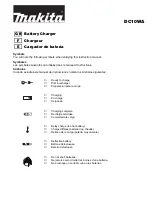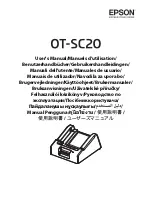
cpin002568
3
2
3. Remove the battery filler caps and check the level of the liquid in the cells. If necessary,
top up with distilled water and ensure that the liquid is 6mm (1/4”) above the top of the plates.
Do not replace the filler caps until the charging program has been completed.
4. Connect the clips to the battery terminals ensuring they bite firmly and polarity is correct.
The red LED ‘connected’ will light to indicate that the charger is correctly connected to your
battery. However if the red LED does not illuminate check the following points on next page.
• Ensure that the positive (red) clip is connected to the positive (+) battery terminal.
• The red or black clips may not be making good electrical contact. Twist the clips to ensure good
electrical contact on battery terminals.
• Your battery may be completely flat or have damaged cells. Care should be taken when attempting
to charge this battery. Refer to section headed “Overload”.
5. Plug the battery charger into a regular household powerpoint (240 Volt), and switch power ‘ON’.
The red and yellow LEDs will illuminate to indicate that the battery is being charged.
Note: DuriNg the chargiNg process the battery will be gassiNg (bubbliNg quite
freely) aND emittiNg hyDrogeN gas. Do Not use a NakeD flame Near the battery.
6. When the green LED is illuminated the battery is charged. Switch power ‘OFF’ before removing
the clips from the battery.
CHARGING TIMES
OVERLOAD
LOW MAINTENANCE BATTERIES
IMPORTANT NOTES
SAFETY INFORMATION
1. If the battery is in reasonable condition, it should be sufficiently charged to start a vehicle when
the green LED indicator is illuminated.
2. Charging the battery overnight (12-15 hours) is usually enough to fully charge a flat car battery,
although a vehicle may start after only a short period of charging. Do not charge your battery for
more than 24 hours as this will cause deterioration of the battery cells.
3. Smaller capacity motorcycle batteries may only need 4-6 hours to restore the battery to peak
condition.
If your battery is flat and all three LED’s illuminate when you first switch the charger ‘ON’ it is acceptable
to continue charging your battery for several hours. The green ‘charged’ LED should eventually
switch ‘OFF’ then illuminate again when the battery is charged.
This situation generally occurs when the battery has been neglected and not charged for
several months.
If all three LED’s are illuminated for several hours when the battery is first connected and the green
LED does not switch ‘OFF’ it is recommended that your battery is tested by an automotive electrician.
Prolonged charging of very flat or damaged batteries may cause the thermal overload switch to
operate (switching the charger ‘ON’ and ‘OFF’ automatically until the battery has achieved a
satisfactory charge). The LED meter will be ‘cycling’, i.e. blinking ‘OFF’ and ‘ON’ at short intervals.
This ‘cycling’ will not cause damage to either charger or battery, unless it continues for more than
2 hours. At this stage you should have the battery checked by a automotive electrician and cease
charging to avoid damage to the battery or charger.
When the liquid in the battery starts gassing (bubbling) freely, the battery is well charged and
ready for use.
Low maintenance batteries should not be overcharged. It is advisable to disconnect the charger
as soon as the green LED on the meter becomes illuminated.
Note: sealeD or low maiNteNaNce type batteries are easily recogNisable as they
Do Not have removable filler caps. refer to the maNufacturer’s iNstructioNs
before attemptiNg to recharge the battery.
• This charger is designed to charge 12 volt automotive lead-acid batteries of capacity in the
range 10 to 60 amp-hours. Most small motor car batteries are in this range.
• Do not attempt to charge batteries of other types.
• This charger is not to be used by young children or infirm persons without supervision.
Do not allow young children to play with the charger.
• Ideally, disconnect the battery and remove from the vehicle before charging. If this is not
pratical, ensure that the battery terminal not connected to the chassis is connected first to the
charger. The other connection is then made to the chassis, keeping away from the battery and
fuel line. Only after connecting, switch on the main supply to the charger.
• After charging, switch off the mains supply. Then remove the chassis connection and the
battery connection, in this order.
WARNING:
Working in the vicinity of a lead acid battery is dangerous due to the emission of
explosive gases. These explosive gases can be ignited by a spark, cigarette or naked flame such
as a cigarette lighter or matches.
• Keep sparks and naked flames away from battery at all times.
• Never smoke or light a cigarette near a battery.
• Take extreme care with metal objects and tools including items of jewellery such as rings and
watch bands. Metal objects touching the battery terminals may cause sparks or serious heat
burns to the user or wearer.
• Do not allow tools to drop on the battery and never temporarily place tools on top of a battery.
• When testing or working on or around a lead acid battery it is advisable to wear protective eye
glasses.
• When testing or charging a lead acid battery, ensure that the area you are working in has plenty
of ventilation. Never test or charge a battery in a confined area.
• Do not use the charger in the rain or expose it to water from hoses or sprinklers. Lead acid
batteries contain Sulphuric Acid. If acid contacts the skin or clothing, flush immediately with
large amounts of water.
IN CASE OF ACCIDENTAL EYE CONTACT WITH BATTERY ACID, FLUSH EYES FOR AT LEAST FIVE
MINUTES WITH CLEAN WATER. THE EYES SHOULD BE SUBMERGED UNDER WATER AND KEPT
OPEN. SEE A DOCTOR IMMEDIATELY. DO NOT USE EYE DROPS OR OTHER MEDICATION UNLESS
INSTRUCTED BY A DOCTOR.




















